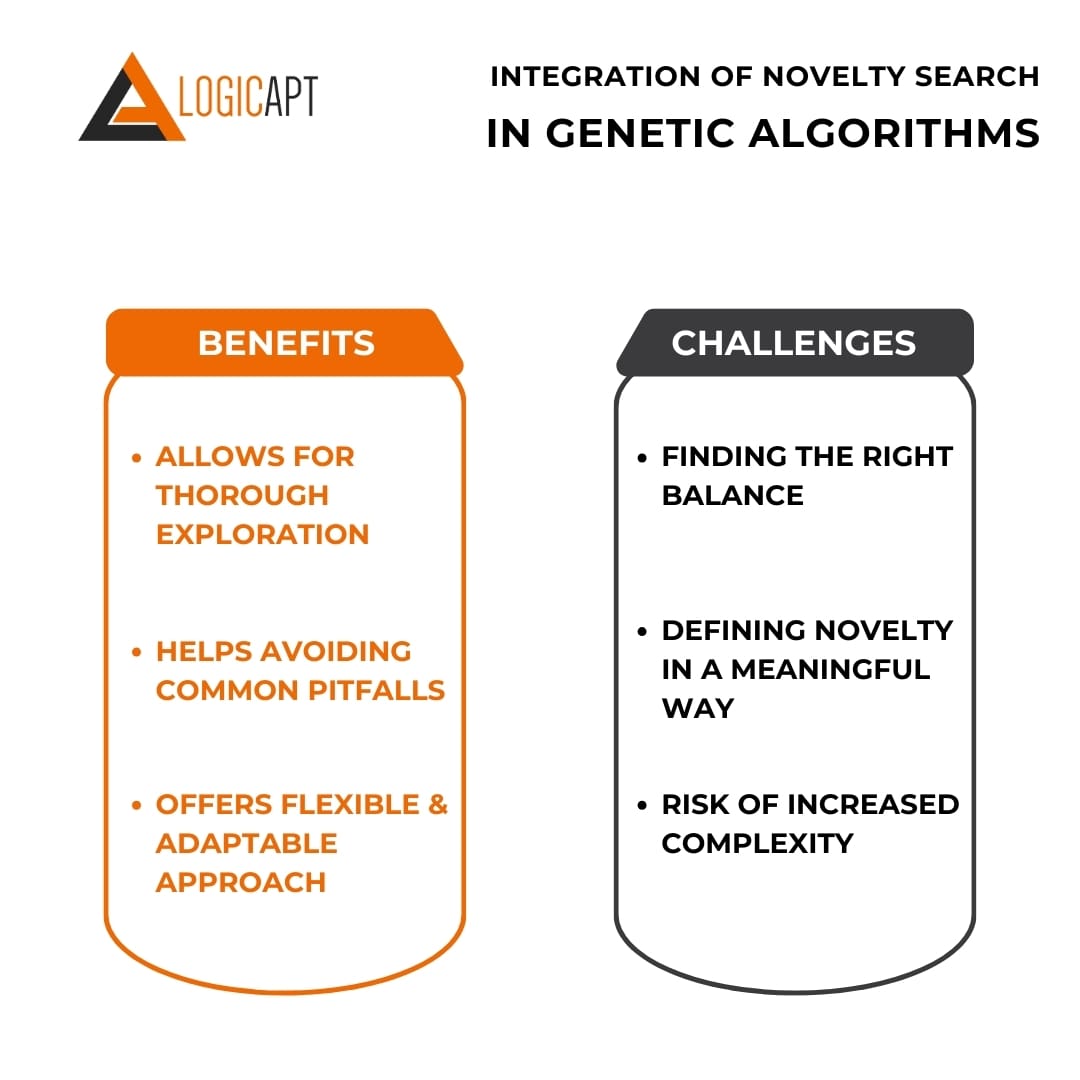The Comprehensive Guide to Novelty Search: Revolutionizing Evolutionary Algorithms

Introduction
Novelty Search: A Paradigm Shift in Evolutionary Computation
The world of evolutionary algorithms is witnessing a significant shift, and at the heart of this transformation is 'Novelty Search.'
Brief Overview of Novelty Search
Novelty search isn't just another algorithm; it's a revolutionary approach that challenges conventional evolutionary computation methods. Unlike traditional algorithms focusing on specific objectives or goals, novelty search operates on a unique principle. It abandons traditional objectives, opting to explore uncharted territories by rewarding uniqueness and innovation. This method prioritizes discovering novel solutions over-optimizing predefined objectives, leading to potentially groundbreaking and unexpected outcomes.
Importance in the Current Technological & Patent Landscape
Now, in a rapidly evolving technological landscape, the significance of novelty search cannot be understated. This approach aligns perfectly with the need for innovative solutions in complex, dynamic environments where conventional methods falter. Whether in artificial intelligence, robotics, or complex system optimization, novelty search offers a fresh perspective, paving the way for advancements that traditional objective-driven approaches might miss.
Acknowledging Traditional Methods and Their Limitations
You might be wondering why there's a need to move beyond traditional evolutionary algorithms. The answer lies in their inherent limitations. Traditional methods often need help in local optima, leading to suboptimal solutions. They are also prone to overfitting and cannot adapt to dynamic environments. This is where novelty search steps in, introducing a paradigm where the journey toward discovery is as important as the destination itself. Exploring new and untested solutions avoids the pitfalls of conventional optimization, fostering a landscape ripe for innovation and unforeseen possibilities.
Understanding Novelty Search
Redefining the Approach to Evolutionary Computation
In evolutionary algorithms, novelty search emerges as a beacon of innovation, challenging the status quo and offering a new way to explore problem-solving.
Definition and Meaning of Novelty Search
Novelty search fundamentally redefines the approach to evolutionary computation. It is a method where the search process is driven not by how sound solutions perform against a predetermined objective but by how different these solutions are from what has been seen before. This approach is grounded in the belief that the most innovative and effective solutions often arise from paths less traveled. Novelty search prioritizes diversity and uniqueness, shifting from the traditional objective-oriented problem-solving strategy.

Contrast with Traditional Objective-Based Search
Traditional objective-based search, the longstanding pillar of evolutionary algorithms, operates on a fundamentally different principle. It focuses on optimizing specific goals or objectives, often leading to a concentrated search in a limited area of the solution space. This can result in rapid convergence to local optima, potentially overlooking more innovative or effective solutions in unexplored regions. In contrast, novelty search thrives on exploration. It's akin to an adventurer who values discovering new lands over the riches of known territories. This shift from a goal-focused search to an exploration-driven approach sets novelty search apart, offering a broader, more holistic view of the problem-solving landscape.
Introducing Novelty Search as a Paradigm Shift in Evolutionary Computation
Novelty search isn’t just a new algorithm; it's a paradigm shift in approaching problem-solving in computational intelligence. It promises a world where algorithms are not confined by the limits of predefined objectives but are empowered to explore, innovate, and discover. This shift holds immense potential for fields where conventional approaches have plateaued, offering a fresh lens through which complex problems can be viewed and solved. Novelty search, with its emphasis on diversity and exploration, is more than just an algorithm – it's a new philosophy in evolutionary computation, promising to unlock doors to solutions that were previously beyond our reach.
The Evolution of Novelty Search Algorithms
Tracing the Roots of a Computational Revolution
The journey of novelty search algorithms is a tale of evolving perspectives and groundbreaking realizations in evolutionary computation.
Historical Development of Novelty Search
Novelty Search is the culmination of years of research and experimentation in evolutionary algorithms. This idea was planted as researchers began noticing the limitations of traditional objective-based methods, particularly in complex, dynamic environments where predefined objectives could not adequately capture the essence of a problem. The early 2000s witnessed a growing interest in alternative approaches, leading to the conceptualization of novelty search. Pioneers in this field started experimenting with algorithms that valued uniqueness and diversity over specific goal attainment, laying the groundwork for a novelty search.
The Shift from "Abandoning Objectives" to "Evolution through the Search for Novelty Alone"
This shift is monumental. Initially, the concept of abandoning objectives was met with skepticism. Traditional objective-based algorithms were deeply entrenched in the fabric of evolutionary computation. The idea of "evolution through the search for novelty alone" seemed radical, even counterintuitive. However, as more researchers began exploring this avenue, the benefits became increasingly evident. Novelty search algorithms demonstrated an uncanny ability to escape the traps of local optima, a common pitfall in traditional methods. This paradigm shift wasn't just about discarding objectives; it was about redefining success in evolutionary algorithms, focusing on the process of discovery and exploration.
Key Principles and Mechanics of Novelty Search Algorithms
What’s the bottom line? The core of novelty search lies in its distinct principles and mechanics. The fundamental principles include:
- Diversity Over Optimality: Unlike traditional algorithms that optimize for a set goal, novelty search rewards solutions that differ from those previously encountered.
- Exploration of the Solution Space: It encourages a thorough exploration of the solution space, uncovering areas that objective-based searches might overlook.
The mechanics involve:
- Novelty Metrics: Implementing a metric to quantify how different a solution is from previous solutions.
- Selection Process: Solutions are selected based on their novelty scores, not their performance against a predefined objective.
- Continuous Adaptation: The algorithm continually adapts, updating its understanding of what constitutes novelty as the search progresses.
Novelty Search in Genetic Algorithms

Revolutionizing Genetic Algorithms with Novelty Search
In the intricate world of genetic algorithms, the infusion of novelty search principles is akin to a fresh wave of innovation, reshaping traditional approaches.
Integration of Novelty Search in Genetic Algorithms
Genetic algorithms (GAs) have long been celebrated for their ability to solve complex optimization problems by mimicking natural evolutionary processes. However, integrating novelty search into GAs has marked a significant shift in their application. This integration involves replacing or complementing the traditional fitness-based selection process with a novelty-driven approach. In this hybrid model, the genetic algorithm evolves not by striving for the fittest solution but by exploring novel solutions that differ significantly from those previously generated. This integration allows GAs to break free from the constraints of local optima and explore a much broader solution space.
Case Studies and Examples
- Robotics and Pathfinding: One of the most illustrative examples of novelty search in GAs is robotics, particularly in complex pathfinding tasks. Robots programmed with novelty-search-based GAs have demonstrated an enhanced ability to navigate unpredictable terrains by exploring unique paths rather than the shortest or most efficient ones dictated by traditional GAs.
- Biological Modeling: Another example is biological modeling, where novelty search has been used to simulate evolutionary processes driven not solely by survival of the fittest but also by unique adaptations and mutations.
Benefits and Challenges
- Enhanced Exploration: It allows for a more thorough exploration of the solution space, uncovering potentially innovative solutions.
- Avoidance of Local Optima: Novelty search helps circumvent the common pitfall of GAs getting stuck in local optima.
- Flexibility and Adaptability: It provides a flexible approach that adapts over time, making it suitable for dynamic and complex problem spaces.
There are challenges, too:
- Balancing Novelty and Fitness: Finding the right balance between novelty and traditional fitness objectives can be tricky, as more than prioritizing novelty might lead to impractical solutions.
- Defining Novelty: Quantifying novelty in a meaningful way that aligns with the goals of the GA can be challenging.
- Computational Overhead: Implementing novelty search can increase the genetic algorithm's computational complexity and resource requirements.
Novelty Search Python Implementation
Harnessing Python's Power for Novelty Search Algorithms
With its simplicity and a vast array of libraries, Python stands as an ideal language for implementing and experimenting with novelty search algorithms.
Introduction to Python for Novelty Search
You might wonder why Python is widely used in novelty search implementations. The reason is its simplicity, extensive library support, and the active community that continually contributes to its development. Python's libraries like NumPy, SciPy, and DEAP (Distributed Evolutionary Algorithms in Python) provide powerful tools for creating and manipulating genetic algorithms, making it an excellent choice for implementing novelty search models. Its ability to handle complex calculations and data manipulations efficiently makes it a go-to language for researchers and developers in evolutionary computation.
Tutorial on Basic Novelty Search Algorithm in Python
- Setup: Install necessary Python libraries like DEAP.
- Defining Novelty Metric: Create a function to calculate the novelty of a solution. This could be based on how different the solution is from others regarding specific features or behaviors.
- Population Initialization: Initialize a population of random solutions.
- Evaluation Loop:
- Evaluate the novelty of each solution in the population.
- Select the most novel solutions to create a new generation.
- Apply genetic operators like crossover and mutation to introduce variations.
- Iteration: Repeat the evaluation loop for several generations or until a termination condition is met.
Showcasing Python’s Flexibility in Implementing Complex Novelty Search Models
It gets better: Python's true strength lies in its ability to handle more complex novelty search models. With advanced features and libraries, Python can implement multi-objective novelty search algorithms, parallel processing for handling large populations, and even integrating machine learning techniques for adaptive novelty metrics. This flexibility makes Python an invaluable tool in pushing the boundaries of what novelty search algorithms can achieve, from simple proof-of-concept models to sophisticated systems capable of tackling real-world problems.
The Legal Landscape: Novelty Search Patent and Patentability
Navigating the Complexities of Patent Law in Novelty Search
In the intricate world of intellectual property, understanding the nuances of patent law concerning novelty search is crucial for innovators and researchers.
Overview of Novelty Search Patents
Now, let's delve into the realm of patents in the context of novelty search. A patent provides legal protection for a new invention or process, and in the case of novelty search algorithms, this could include unique methods, implementations, or applications. Securing a patent for a novelty search algorithm involves demonstrating that the algorithm is new and unique but also non-obvious and helpful. The landscape of novelty search patents is diverse, covering various implementations in areas like machine learning, robotics, and evolutionary computation. These patents reflect the growing recognition of the value and innovation that novelty search brings to these fields.
The Process and Importance of Patentability Novelty Search

Conducting a thorough patentability novelty search is essential before filing for a patent. This process involves searching existing patents and published applications to ensure the proposed invention is novel and non-obvious. The importance of this step cannot be overstated. It helps in:
- Avoiding Infringement: Ensuring the invention does not unintentionally infringe on existing patents.
- Strengthening Patent Applications: Providing evidence of novelty and non-obviousness critical for patent approval.
- Saving Time and Resources: Identifying potential patentability issues can save considerable time and resources that would otherwise be spent on a futile patent application process.
Key Considerations and Best Practices in Patent Novelty Search
Some best practices include:
- Comprehensive Search: Use multiple databases and search tools to cover as much ground as possible.
- Expert Assistance: Consider consulting with a patent attorney or a professional search firm, especially for complex novelty search algorithms.
- Documentation: Keep detailed records of the search process and findings, which can be invaluable during the patent application process.
- Continuous Monitoring: Even after a patent is filed, it's essential to continuously monitor the patent landscape, as new filings could impact the status of your patent.
Novelty Search Reports and Documentation
Essential Insights: The Role of Reporting in Novelty Search
Accurate and comprehensive reporting is the backbone of effective novelty search strategies, providing critical insights and guiding future innovations.
Importance of Thorough Reporting in Novelty Search
Now, let's discuss why thorough reporting is pivotal in novelty search. Tracking and documenting each process step is crucial in a field where exploration and uniqueness are prized. Thorough reporting:
- Ensures Transparency: It provides a clear and detailed account of how results were obtained, making the process replicable and verifiable.
- Facilitates Analysis: Detailed reports allow researchers to analyze the outcomes comprehensively, identifying patterns and insights that might not be apparent initially.
- Aids in Continuous Improvement: By documenting successes and failures, reports serve as a foundation for refining and enhancing novelty search strategies.
Components of an Effective Novelty Search Report
Key components include:
- Executive Summary: A brief overview of the objectives, methods, and key findings.
- Methodology: Detailed description of the novelty search algorithm used, including the novelty metrics and selection process.
- Results: Presentation of the findings, preferably with visual aids like graphs or charts, to illustrate the diversity and novelty of the solutions found.
- Analysis: Interpretation of the results, discussing how the findings align with the goals of the novelty search and any interesting or unexpected outcomes.
- Conclusions and Recommendations: Summarize the key takeaways and propose future directions or improvements based on the findings.
- Appendices: Providing raw data, code snippets, or detailed descriptions of specific algorithms or calculations for those who wish to delve deeper.
How Reports Aid in Understanding and Improving Novelty Search Strategies
Well-structured reports are more than just a record of what was done; they are tools for learning and advancement. They aid in:
- Benchmarking Progress: By comparing reports over time, researchers can track the evolution and improvement of their novelty search strategies.
- Sharing Knowledge: Reports serve as a means to communicate findings with the broader community, fostering collaboration and collective learning.
- Guiding Future Research: Insights from reports can spark new ideas and directions for future novelty search endeavors.
Novelty Search Applications and Case Studies
Exploring the Frontier: Novelty Search in Action
Novelty search has left its mark across various domains, demonstrating its versatility and effectiveness in tackling complex challenges.
Real-World Applications of Novelty Search
Novelty search is not just a theoretical concept but is actively applied in numerous fields with significant results. Some of its notable applications include:
- Robotics: In robotics, novelty search has been used to develop adaptive behaviors in robots, allowing them to navigate and interact with dynamic environments more effectively than traditional objective-based methods.
- Artificial Intelligence and Machine Learning: AI and ML have benefited from novelty searches in areas like neural network training, which helps discover unique network architectures and learning strategies.
- Bioinformatics and Drug Discovery: Novelty search aids in exploring vast chemical spaces for new drug compounds, going beyond the limitations of traditional methods focusing on specific molecular targets.
- Creative Industries: In game design and digital art, novelty search algorithms generate unique and diverse content, enhancing creativity and innovation.
Detailed Case Studies Showcasing the Impact and Results of Novelty Search
Case Study 1: Robotics and Autonomous Navigation
- Background: A project involving autonomous robots navigating complex terrains.
- Implementation: Using novelty search to evolve neural networks that control robot behaviors.
- Results: Robots developed diverse strategies for navigation, some of which were more effective and less predictable than those derived from traditional objective-based approaches.
Case Study 2: Innovative Neural Network Design in AI
- Background: The challenge of creating efficient and robust neural network architectures.
- Implementation: Applying novelty search to evolve neural network designs, focusing on unique and unconventional structures.
- Results: Discovery of novel network architectures outperforming traditional designs in specific tasks, demonstrating the potential of exploration-driven AI development.
Future of Novelty Search: Trends and Predictions
Charting the Uncharted: The Evolving Landscape of Novelty Search
As novelty search continues to evolve, it's poised to redefine problem-solving and innovation in numerous domains.
Emerging Trends in Novelty Search
Recent advancements and growing interest in this area have led to several key trends:
- Integration with Machine Learning and AI: There's an increasing convergence of novelty search with advanced AI and machine learning techniques, leading to more sophisticated and adaptive algorithms.
- Application in Complex Systems: Novelty search is increasingly applied to complex systems, such as climate modeling and financial forecasting, where traditional models struggle.
- Collaborative and Open-Source Projects: The rise of collaborative and open-source projects in the novelty search arena promotes incredible innovation and faster development of new techniques.
Predictions for Future Developments and Applications
Looking ahead, we can predict several developments:
- Broader Industry Adoption: Expect to see novelty searches adopted by more industries, especially those dealing with complex, dynamic systems like logistics and urban planning.
- Enhanced Computational Efficiency: As computational power increases and algorithms refine, novelty search will become more efficient and accessible.
- Cross-Disciplinary Innovations: Novelty search will likely spur innovations at the intersection of different fields, such as bioengineering, cognitive science, and artificial intelligence.
The Potential Impact on Various Industries and Research Fields
The future of novelty search holds immense potential for various industries and research fields. Its impact could be particularly transformative in areas such as:
- Healthcare and Medicine: From drug discovery to personalized medicine, novelty search can drive significant advancements.
- Environmental Science: In addressing climate change and environmental conservation, novelty search can help model complex ecosystems and predict future changes.
- Creative Industries: It will continue revolutionizing creative fields by providing tools for generating innovative designs, artworks, and interactive experiences.
Conclusion
Embracing the Future with Novelty Search: A Call to Innovation
As we stand at the cusp of a new era in evolutionary computation, novelty search emerges as a methodology and a beacon of innovation and exploration.
Summary of Key Points
- Revolutionary Approach: Novelty search represents a paradigm shift from traditional objective-based evolutionary algorithms to a focus on exploration and diversity.
- Diverse Applications: It has proven its versatility across various fields, from robotics and AI to bioinformatics and creative industries, showcasing its ability to tackle complex and dynamic problems.
- Legal and Practical Aspects: The discussion on patents and reporting underscores the practical and legal nuances in implementing and protecting novelty search innovations.
The Future Scope of Novelty Search
The future of novelty search is not just promising; it's transformative. As computational capabilities grow and understanding deepens, novelty search is poised to unlock solutions to some of the most challenging and intricate problems facing various industries. Its potential to foster unorthodox approaches and creative problem-solving will likely drive the next wave of technological and scientific advancements.
For researchers, developers, and innovators, this means:
- Exploring Novelty Search: Delve into the world of novelty search, experiment with its principles, and apply them to your domain.
- Pushing Boundaries: Challenge the status quo of traditional algorithms and be open to the unconventional paths novelty search may lead you down.
- Collaborating and Sharing Knowledge: Engage with the community, share insights, and collaborate to develop further and apply novelty search.

Closing Thoughts
It gets better: as we harness the power of novelty search, we open doors to a world brimming with possibilities. A world where the quest for the novel and the unique drives progress and where the boundaries of innovation are continually expanded. The journey of novelty search is just beginning, and its path is as exciting as the destinations it promises to unveil.
References and Further Reading
The following references and resources are invaluable to further your understanding of novelty search and stay abreast of the latest developments.
- Academic Journals and Papers
- Look for pioneering research papers and journal articles that first introduced and developed the concept of novelty search.
- Recent publications focus on the application of novelty search in various fields.
- Books
- Titles that delve into evolutionary algorithms and novelty search, offering both theoretical background and practical applications.
- Online Resources
- Dedicated forums and websites where researchers and practitioners discuss novelty searches.
- Repositories hosting open-source novelty search projects or code samples.
- Patent Databases
- Exploring patent databases can provide insights into the legal aspects and the innovative applications of novelty search that have been patented.
- Industry Reports and Case Studies
- Reports from leading tech companies or research institutions that have applied novelty search in real-world scenarios.
- Detailed case studies showcasing the implementation and results of novelty search strategies.
- Conferences and Workshops
- Information on relevant conferences, workshops, or seminars focusing on novelty search and related areas in evolutionary computation.
- Video Lectures and Tutorials
- Educational videos and online tutorials that provide step-by-step guidance on implementing novelty search algorithms, especially in programming languages like Python.
- Blogs and Thought Leadership Articles
- Blogs by experts in the field offering insights, opinions, and updates on the latest trends and developments in novelty search.

